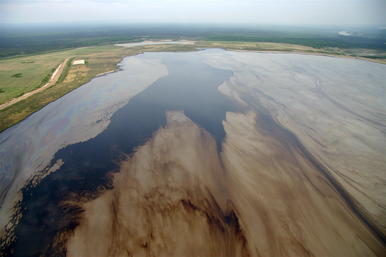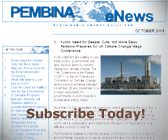$ 114,477,793
|
Take Action Now!One Quarter of Alberta Could Be Mined or Drilled for Oil Sands with Major Impacts to Boreal Forest, Water, Air and ClimateNote that the public consultation process ended on October 4th, 2006. Thanks to those who took part in the process! What should Alberta look like during and after oil sands development? Are you worried about water, the boreal forest or sky-rocketing greenhouse gas pollution? The Oil Sands Multi-stakeholder Committee has been formed to lead a public consultation on the development of oil sands. Have your say at one of the seven public consultation sessions across Alberta. The Pembina institute will be making presentations at public consultation sessions on the development of oil sands and encourage not only Albertans, but all citizens to submit their concerns and vision for the future of oil sands development. Take Action: Have a Say About Your Future
For more information about the consultation process visit www.oilsandsconsultations.gov.ab.ca/ Hearings Near You:
Hearings Follow this Agenda:
Why Your Voice Is ImportantThe manner in which oil sands are developed will affect our social, environmental and economic future. Alberta does not have plans to deal with the current "boom" phase of oil sands development and very serious infrastructure, labour and planning issues are surfacing all over Alberta. The rate at which the oil sands are being developed is exceeding the capacity of the environment to absorb the impacts, and the government's plans to manage the impacts is sorely lacking. Oil sands operations have major impacts on our air, land, wildlife and water. For an overview of the environmental and climate change implications of oil sands development take a look at the Oil Sands Fever book or fact sheet. One Quarter of A Rather Large ProvinceAlthough oil sands strip mining near Fort McMurray has received most of the attention to date, 80% of Alberta's oil sands reserves are too deep to be mined and must be extracted through in situ (in place) techniques. With no public discussion, and without a plan in place to protect the forest, the Imagine a piece of land the size of Florida developed for oil sands. Alberta Government has already leased 35,000 km2 of boreal forest for deep oil sands development and is set to lease up to 21% — almost one quarter of Alberta, for oil sands development. Wildlife experts expect significant impact on the health of the boreal forest and predict the local extinction of the already threatened woodland caribou. Visit our website: www.oilsandswatch.org and see photos of oil sands development. To learn more, see the Death by a Thousand Cuts report or fact sheet. Air PollutionOil sands operations are expected to triple within the next 10 years. Already oil sands are the fastest growing new source of greenhouse gas pollution in Canada. By 2012 they are expected to more than double. There is a major disconnect between Canada's position (since 1990) that emissions need to be reduced dramatically and the skyrocketing emissions caused by oil sands development. Pollution — such as the emissions that cause acid rain — is expected to rise rapidly, threatening human health and the viability of forest soils and lakes in a vast area. Find out more... Major Water Consumption & PollutionApproved and operating oil sands operations are already allowed to withdraw enough water to meet the needs of a city of 2 million people each and every day. Oil sands Toxic tailings ponds already cover 50 square kilometres of land. mining and upgrading operations require 2-4 barrels of water per barrel of oil produced. Most of the water taken from the Athabasca River for oil sands mining and upgrading operations winds up in toxic tailings ponds that already cover 50 square kilometres of land and can not be released back into the ecosystem. Limits must be established. Troubled Waters summary report. Down to the Last Drop fact sheet. |
|






